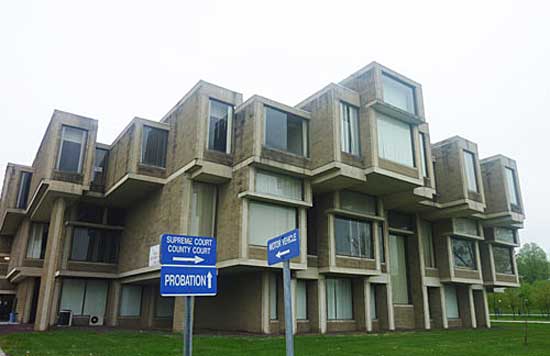“Where’s Kimmelman?” I had asked the end of one of my many posts (beginning with this one) about the need to save Brutalist architect Paul Rudolph‘s endangered Orange County Government Center, Goshen, NY. Almost three years later, the NY Times‘ architecture critic, seemingly more intent upon writing about urban planning issues than architectural achievements, has at last turned his attention to this:

Photo by Lee Rosenbaum
Until now, it has fallen to the Times’ veteran arts writer, Robin Pogrebin, to cover the controversy—a political football in Orange County. As a journalist, not a critic, she could lay out the issues but not argue for the building’s rescue. Influential Vanity Fair architecture critic Paul Goldberger was an early defender.
Now Michael has very belatedly championed this important (but sadly deteriorated) building, which was placed on the World Monuments Fund’s 2012 Watch List of endangered cultural-heritage sites: “Unless county legislators act quickly,” Kimmelman writes, “a paragon of midcentury American idealism will be lost.”
He has thrown his weight behind an offer by architect Gene Kaufman, owner and principal of Gwathmey Siegel Kaufman Architects, to buy Rudolph’s building for $5 million, convert it into an arts center and (if desired by the county) design a new government center on the building’s current parking lot.
According to Kaufman’s 166-page proposal:
The building is an architectural masterpiece whose design will be a major attraction for the artist tenants, who will likely regard it as the most fabulous kind of building they could imagine for producing art….The building is perfectly suited for artist studio and live-work space with only minor renovation work and cost.
Not so fast, says a high-profile local advocate for saving the building: Michael Sussman, Goshen attorney and activist Democrat, argues that Kaufman should pay $15 million, not $5 million, for the building, upon condition that the architect also be awarded a contract to design a replacement Government Center.
As you’ll see at the beginning of my CultureGrrl Video, at the bottom of this post (shot in 2012), Sussman had previously asserted that it was “fiscally irresponsible” to build a new building, and at that time advocated renovating the Rudolph building for its intended purpose.

Photo by Lee Rosenbaum
My guess is that brutally honest assessments of the Brutalist building’s defects and dilapidation (reflected in an admiring but frank 2012 appraisal by architecture critic James Russell), have led even its staunchest advocates to conclude that some new construction is needed.
County Executive Steve Neuhaus earlier this month vetoed a measure passed by the County Legislature that would have permitted it to consider selling the Government Center. Chris McKenna of the Times Herald-Record detailed Neuhaus’ reasons for opposing Kaufman’s plans:
He argued that Village of Goshen officials’ resistance to the “Orange Arts” plan and the threat of sanctions by state court officials made the proposal unworkable. Court officials have been pressing the county for more than three years to reopen or replace the lost court space in the closed complex.
Neuhaus wants to start work within a few months on a $74-million renovation of the existing building and an expansion that Kimmelman pummels as “an especially soul-crushing glass box.” But first, the legislature gets a chance to override county executive’s veto with a two-thirds majority, an outcome advocated by the Times Herald-Record in its recent editorial.
Kimmelman inadvertently undermines his own credibility by muddling his facts at the end of his article, where he suggests that Orange County legislators (but not the county executive?) head over to New Haven to visit Yale University’s Rudolph-designed Art and Architecture Building (now renamed Rudolph Hall).
His misinformed description of its interior suggests that he too ought to head to New Haven:
Opened in 1963, it [Yale’s Rudolph Hall] was restored several years ago by the firm of Gwathmey Siegel. Ugly partitions and drop ceilings from an unfortunate renovation were stripped away [emphasis added] ….Almost miraculous, the restoration vindicates Rudolph.
Um, not exactly.
When I visited Rudolph Hall in 2012, four years after its 2008 restoration, its effect was hardly “miraculous.” It sported multitude of makeshift “ugly partitions”:

Photo by Lee Rosenbaum
It also conspicuously featured a “drop ceiling” that was not “stripped away,” as Kimmelman reported, but had been added to the monumental central space, as part of its 2008 Gwathmey Siegel re-do. A discordant bright-white glossy grid, the drop ceiling concealed the heating and cooling apparatus:

Photo by Lee Rosenbaum
As I suggested in this post, this dispiriting result bespeaks an uneasy fit between the form of Rudolph’s structure and its function—a criticism that has also been leveled at his Goshen edifice.
Time-travel with me now back to 2012, when the controversies swirling about Rudolph’s syncopated-cube composition came to a head at an Orange County Legislature public hearing that I attended. Up first: attorney Sussman, followed by a spokesperson for the World Monuments Fund, an architecture student and an irate local attorney, blasting the unsuitability of the courtrooms:
